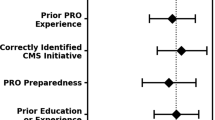Abstract
OBJECTIVE: To determine whether educational sessions with medical residents, with or without letters to their patients, improve patient satisfaction with transfer of their care from a departing to a new resident in an internal medicine clinic.
DESIGN: Observational study in Year 1 to establish a historical control, with a randomized intervention in Year 2.
SETTING: An internal medicine clinic in a teaching hospital.
PATIENTS/PARTICIPANTS: Patients of departing residents completed questionnaires in the waiting room at their first visit with a new resident, with mail-administered questionnaires for patients not presenting to the clinic within 3 months after transfer of their care. In Year 1, 376 patients completed questionnaires without intervention. The following spring, we conducted interactive seminars with 12 senior residents to improve their transfer of care skills (first intervention). Half of their patients were then randomized to receive a letter from the new doctor informing them of the change (second intervention). We assessed the efficacy of the interventions by administering questionnaires to 437 patients in the months following the interventions.
MEASUREMENTS AND MAIN RESULTS: Multivariate analysis of Year 1 results identified doctors personally informing patients prior to leaving as the single strongest predictor of patient satisfaction (partial R 2=.41). In Year 2, our first intervention increased the percentage of patients informed by their doctors from 71% in 1991 to 79% in 1992 (P<.001). Mean satisfaction dramatically improved, with the fraction of fully satisfied patients increasing from 47% at baseline, to 61% with the first intervention alone, and 72% with both interventions (P<.0001).
CONCLUSIONS: Simple methods such as resident education and direct mailings to patients significantly ease the difficult process of transferring patients from one physician to another. This has implications not only for residency programs, but for managed care networks competing to attract and retain patients.
Similar content being viewed by others
References
Rogers J, Curtis P. The concept and measurement of continuity in primary care. Am J Public Health. 1980;70:122–7.
Hjortdahl P, Laerum E. Continuity of care in general practice: effect on patient satisfaction. BMJ. 1992;304:1287–90.
Baker R. Characteristics of practices, general practitioners and patients related to levels of patients’ satisfaction with consultations. Br J Gen Pract. 1996;46:601–5.
Wasson JH, Sauvigne AE, Mogielnicki RP, et al. Continuity of outpatient medical care in elderly men. A randomized trial. JAMA. 1984;252:2413–7.
Roy MJ, Kroenke K, Herbers JE. When the physician leaves the patient: predictors of satisfaction with the transfer of care in a primary care clinic. J Gen Intern Med. 1995;10:206–10.
Hulka BS, Cassel JC, Kupper LL, Burdette JA. Communication, compliance, and concordance between physicians and patients with prescribed medications. Am J Public Health. 1976;66:847–53.
Linn MW, Linn BS, Stein SR. Satisfaction with ambulatory care and compliance in older patients. Med Care. 1982;20:606–14.
Wartman SA, Morlock LL, Malitz FE, Palm EA. Patient understanding and satisfaction as predictors of compliance. Med Care. 1983;21:886–91.
Weisman CS, Nathanson CA. Professional satisfaction and client outcomes: a comparative organizational analysis. Med Care. 1985;23:1179–92.
Yancy WS, Macpherson DS, Hanusa BH, et al. Patient satisfaction in resident and ambulatory care clinics. J Gen Intern Med. 2001;16:755–62.
Johnson JE, Pinholt EM, Jenkins TR, Carpenter JL. Content of ambulatory internal medicine practice in an academic Army medical center and an Army community hospital. Mil Med. 1988;153:21–5.
Jackson JL, Strong J, Cheng EY, Meyer G. Patients, diagnoses, and procedures in a military internal medicine clinic: comparison with civilian practices. Mil Med. 1999;164:194–7.
Jackson JL, O’Malley PG, Kroenke K. A psychometric comparison of military practices. Mil Med. 1999;164:112–5.
Author information
Authors and Affiliations
Corresponding author
Additional information
The opinions or assertions contained herein are the private views of the authors and are not to be considered as official or as reflecting the views of the Department of the Army, the Department of Defense, or the Department of Veterans Affairs.
Rights and permissions
About this article
Cite this article
Roy, M.J., Herbers, J.E., Seidman, A. et al. Improving patient satisfaction with the transfer of care. J GEN INTERN MED 18, 364–369 (2003). https://doi.org/10.1046/j.1525-1497.2003.20747.x
Issue Date:
DOI: https://doi.org/10.1046/j.1525-1497.2003.20747.x



